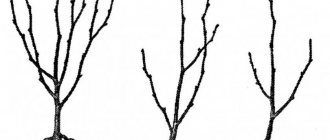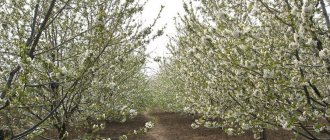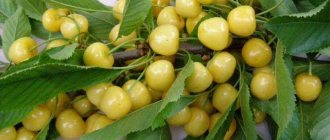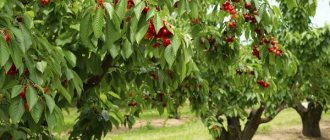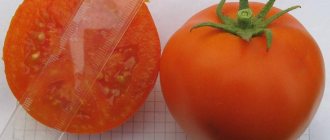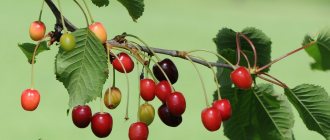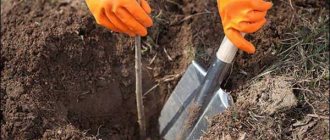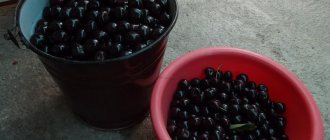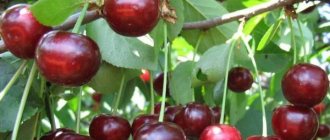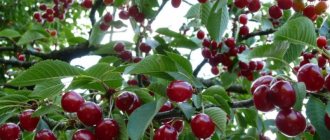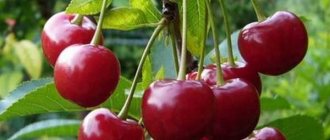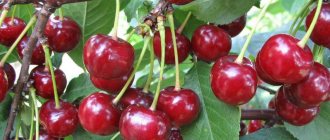Advantages and disadvantages: is it worth planting on the site?
Rossoshanskaya golden cherry has the following advantages:
- High yield.
- High resistance to drought.
- Frost resistance.
- Good quality fruit.
- Low growth, making it easy to harvest.
Disadvantages include:
- The need for a pollinating neighbor.
- Susceptibility to diseases and pests.
- Undesirable proximity to some cultures.
Varieties of crops
Rossoshanskaya cherries are divided into three subspecies: large, black, golden.
Large
It has large berries, each weighing 6.7 grams, dark burgundy in color. The shape is round, slightly flattened on the sides. The tree is low, with a lush crown. During the flowering period it forms large lush white flowers. It takes root in the North Caucasus region.
Black
A tree with a maximum height of 3 m. Lush crown, tightly adjacent leaves, especially on young branches. The color of the berries is almost black, with a red tint. The berries are round in shape, medium, and taste sweet. They are distinguished by good transportability due to their thick skin.
Golden
The tree is not tall, making it easy to harvest. The berries are large and golden in color. If the trees are well lit, they will produce berries with a pink tint. Cherry blossoms bloom with lush white flowers.
History of selection
The Rossoshanskaya variety is the result of selection by Russian scientists at the Rossoshanskaya experimental station, located in the Voronezh district. The author of the described variety of cherries was A. Ya. Voronchikhina. At the same time, the variety is divided into three types: large, black and gold. At the moment, the plant is not included in the state register of fruit and vegetable crops of the Russian Federation, however, it used to be there.
Familiarize yourself with the rules for planting cherry seedlings in the spring.
The tree is recommended for cultivation in Ukraine and the southern regions of the Russian Federation. Cherries have become especially widespread in the Voronezh, Volgograd and Saratov regions.
Brief description of the variety
The cherry tree reaches a height of 3 meters, the crown grows in the form of a pyramid, the foliage is not very dense. The fruits are large, about 50 berries are tied on one branch. The leaves are elongated, lanceolate, green or dark green. The berries are yellow or yellow with a pink tint, large. They have a sweet taste and thick skin.
Crown height and branching
The maximum height of the tree is 3 meters. Due to this size, the fruits are easy to harvest. The crown is spreading in the form of a pyramid. It forms large, long branches towards the bottom of the tree, and shorter ones towards the top.
Pollinator varieties, flowering and fruiting
The Rossoshanskaya golden cherry is self-sterile. To set buds, she needs pollinating neighbors. The flowering periods of these plants must coincide. The following types are suitable:
- Miracle Cherry;
- Night;
- Leningrad cherry;
- Check mark;
- Ovstuzhenka.
In the 4-5th year of the vegetative period, cherries begin to bear fruit. The lifespan of the variety is 25 years. Ovaries that form before this period will not bear fruit.
The tree begins to bloom early - in mid-April. When night frosts occur at this time, the yield is reduced. Lush, large, white flowers are formed. Each flower consists of 5 petals; they form dense inflorescences of 10-15 pieces. The fruiting period is average, the berries ripen by mid-June or early July. They have dense cuttings, which reduces berry drop.
Important! If a pollinator does not grow next to the Rossoshan cherry tree, then the tree will not be able to set fruit after flowering.
Transportability and scope of application of berries
Thanks to their durable peel, the berries tolerate travel and storage well. They are consumed fresh. Used for making compotes, preserves, jams, freezing. This variety is grown for sale in large quantities to the market.
See also
17 best varieties of cherries for the Leningrad region with descriptions and characteristicsRead
Description of the plant and its characteristics
By breeding the described variety of apple trees in the 1920s. of the last century was carried out by the Rossoshansky Zonal Experimental Station, whose breeders pollinated the Kronselsky transparent variety with pollen from Aport Krasny apple trees. Gardeners immediately liked the new hybrid, so after a while, breeders began to improve it. The result of their efforts was the development of many varieties of Rossoshansky apple trees, which have their own characteristics and advantages.
Did you know? Among the apple trees growing in our open spaces, the longest-livers are considered to be wild crops that grow in central Russia and can live up to 150 years.
Here are some of the types of apple trees described:
- Bagryanoye;
- Amazing;
- Striped;
- Lyozhkoe;
- Augustovskoe.
Rossoshan apple trees are winter-hardy and productive hybrids. Most of the described species are recommended for planting in the Belgorod, Voronezh, Volgograd, Kursk and Rostov regions, as well as in the Moscow region, since these regions have similar climatic conditions.
Here are some of the characteristics of this apple crop:
- the trees are medium-sized, have a round and dense crown (the older the plant, the more spreading its crown becomes, therefore, from the third year of life, the crowns require formation);
- the shoots are long, light brown or greenish-brown in color, somewhat curved or drooping (usually this occurs under the weight of the fruit);
- 2–4 year old branches and ends of last year’s growths bear fruit;
- large, rounded, wrinkled, dark green foliage;
- umbrella inflorescences have medium white flowers that completely cover the trees during the flowering period;
- apples are yellow-greenish, with red stripes and slight spotting; on the sunny side - a solid blush; they are round-conical in shape;
- apples are large (with an average weight of 160–200 g), with smooth and matte skin, fine-grained, sweet, juicy and tasty, with a slight wine sourness and a spicy aroma, which becomes more pronounced during storage;
- The pulp of an individual fruit contains up to 10–11 g of sugars and 15 g of vitamins.
Pros and cons of the variety
- Rossoshan apple trees have the following advantages:
- with good care, resistance to various diseases (scab, powdery mildew);
- low susceptibility to pests;
- apples on trees ripen at the same time;
- good shelf life of fruits (without rotting), even if there is high air humidity;
- possibility of transportation over long distances;
- the quality of the crop is improved by cross-pollination;
- able to grow on any soil;
- late-ripening crops make it possible to obtain harvests before the onset of winter frosts;
- varieties have taken root in all regions of Russia.
The disadvantages of the hybrid are few: with improper care or sudden climate change, apple trees may become infected with scab.
Productivity
There is no periodicity in fruiting in Rossoshan apple trees. Thus, one plant at the beginning of this period can produce up to 150 kg of apples, and later - up to 250 kg.
Characteristics
Cherry has good characteristics for planting in open ground. It easily copes with low temperatures and drought, but its immunity is not the most durable.
Resistance to sub-zero temperatures and drought
This cherry variety easily tolerates low temperatures and drought. The tree has a powerful root system, which allows it to obtain water from deep layers of the soil. Does well in dry climates.
What diseases and pests are dangerous for the variety?
The plant is susceptible to attack by harmful insects and diseases. The most common diseases are:
- Moniliosis.
- Coccomycosis.
- Fungal diseases.
The most common insects are:
- Black aphid.
- Cherry fly.
- Leaf rollers.
Landing Features
The transfer of the tree to open ground should be carried out according to the deadlines, to a suitable place. It is important to respect the proximity of cherries; not all plants are suitable for this.
Recommended timing
The tree tolerates low temperatures well, so it is better to plant it for the winter. The favorable period for this is the end of September - beginning of October. Planting is also carried out in spring. To do this, you need to select a seedling before bud formation begins. It is important that all processes of the vegetative period occur after planting, this will strengthen the plant.
Choosing a suitable location
Choose a place for cherries that is well-lit, with minimal risk of flooding the tree, and without drafts. The tree is unpretentious to soil fertility, the main thing is that it is light and well aerated. There should be no other trees closer than 6 meters near the plant. This reduces cherry yields.
Suitable and prohibited neighbors of cherries
Suitable for proximity to cherries are:
- pear;
- apricot;
- other types of cherries;
- peach;
- gooseberry;
- raspberries;
- currant;
- grape.
The tree does not grow well next to plum, apple and cherry trees; you should not plant them next to each other.
Seedling preparation
Seedlings are bought at garden markets. Most often they can be found in the autumn. It is better to choose trees without grafting, with good dense branches. There should be no damage, cracks or scratches on the shoots. It is important to pay attention to the roots so that they do not rot. In the fall, they buy seedlings with fallen leaves, and in the spring with not yet swollen buds.
Important! One-year-old trees take root better than two- and three-year-old trees.
Disembarkation algorithm
Pre-prepare the soil. If it is clayey and heavy, it is mixed with sand. In the acidic environment of the earth, the plant does not take root well, so dolomite flour is added to the soil. Planting is carried out as follows:
- Dig a hole 60 cm deep and 80 cm in diameter.
- A wooden stake is driven into it, which in the future is tied to the seedling to protect it from strong winds.
- Part of the excavated soil is mixed with humus, potassium mineral fertilizers and superphosphate are added.
- The roots of the seedling are straightened, damaged areas are cut off.
- Placed in a hole.
- Sprinkle the top with soil mixed with fertilizers.
- Sprinkle with soil in layers, after which each of them is compacted so that there is no space left with air.
- Pour 10 liters of water into the hole.
Important! The roots are sprinkled with half of the soil dug out of the hole, so that there is a depression around the trunk.
Important nuances regarding planting Rossoshanskaya cherries
Things to consider when disembarking:
- All varieties of Rossoshanskaya are characterized by large annual growth (up to 1 m). In a young seedling, this wood does not have time to ripen before the first cold weather and freezes in winter. Therefore, autumn planting for this cherry is not particularly desirable even in the southern regions.
- The place for the tree is selected on a small hill or closer to the top of the slope - this will ensure good illumination, the absence of stagnation of melt and rain water, and humid air.
Good lighting is the key to abundant cherry yields; in the shade, the berries become noticeably smaller and their taste deteriorates.
- The most suitable soil is loam or sandy loam. Such soil is quite fertile, at the same time it allows water and air to pass through well. Neither acidic nor alkaline substrates are categorically suitable for cherries.
- Rossoshanskaya is quite capricious in matters of neighborhood. It will not grow next to cherry and apple trees. Good “companions” are cherry plum, plum, and any berry bushes.
- At least 10–12 kg of humus or compost and about 200 g of complex mineral fertilizer are added to a planting hole 70–80 cm deep and 60 cm in diameter.
- When planting, do not bury the root collar. Leave it 3-4 cm above the soil surface. When the ground settles, it will drop to just the right level.
When planting Rossoshanskaya cherries, constantly monitor the position of the root collar so that it does not end up buried in the soil.
Video: how to plant cherries correctly
Proper crop care
In order for a crop to grow properly, develop well and produce a lot of harvest, it is necessary to follow the rules of caring for it. With improper care, the yield of cherries decreases.
Watering and loosening the soil
The plant does not really like high moisture. Cherries are watered every 2-3 weeks with water in a volume of 10 liters. When drought occurs, watering is increased to once a week. To determine whether the tree has enough moisture, you need to check the soil near the tree trunk. If it is dry, then there is little moisture, if it is wet, there is enough. The plant does not tolerate waterlogging of the soil.
Loosening of the soil is carried out after each watering and rain. At least once a week, as the tree loves airy soils.
Fertilizing
In the spring, fertilizing is carried out with nitrogenous fertilizers, in the middle of summer - with complex compounds, and before wintering - with phosphorus and potassium fertilizers. To strengthen frost resistance, they are fertilized with complexes containing sodium.
See also
Description and characteristics of the Veda cherry variety, cultivation and careRead
Trimming
In the first year after planting, cherries must be pruned. After transferring to the ground, the central conductor is cut off. This is done to form a lush crown and reduce plant growth. After new shoots sprout, they are pruned again. Until a three-tiered crown is formed. More mature trees are pruned every year, dry branches and dense areas are thinned out to make it easier for the fruit to stay on the branch.
Diseases and pests: control methods and prevention
Sweet cherries require regular treatment against pests and diseases. If it was not possible to prevent the disease, then you need to get rid of it as quickly as possible. If this is not done, the plant will not bear fruit, and in the worst case scenario, it will die.
The most common diseases affecting trees:
- Moniliosis. The shoots begin to dry out, leaves fall off, and rot forms inside the branches. The only way to combat this problem is by cutting off the branches. Garden varnish is applied at the cut site. For prevention, the cherry bark is coated with whitewash every year.
- Coccomycosis. Dark red spots form on the foliage. The leaves gradually turn yellow and fall off. Treatment for this disease is carried out during the period of bud formation and flowering. Use Bordeaux solution.
- Fungal formations. They appear on the bark of a tree and are yellow, gray, blue, and black in color. When growths form, they are cut out and the area is treated with garden varnish. Pieces of growths are burned outside the garden.
Cherries are also attacked by harmful insects that feed on its leaves and fruits. Main insect pests:
- Black aphid. They are located on the bottom of the sheet in the form of a black film. They eat the leaves, which gradually turn yellow and fall off. Insecticides are used to combat them. To avoid attack, it is recommended to spray during the period of bud formation.
- Cherry fly. The most dangerous enemy of cherries. These flies lay larvae on tree branches that actively feed on fruits. It's quite difficult to fight them. Set traps on trees, painted bright yellow. After it has worked, the insects are destroyed. At the same time, the leaves of the tree are treated with Confidor solution.
- Leaf rollers. They feed on the leaves of the plant. After which the leaves turn yellow, fall off, and the quality of the fruit deteriorates. To combat them, the tree is sprayed with a chloroform solution. For prevention, the procedure is carried out twice, in preparation for winter and during the period of bud formation.
Shelter from frost
The tree has good frost resistance. However, it is recommended to cover young trees with completely warm fabrics for the winter. Their frost resistance appears only in the 3rd year of the growing season. For mature trees, moss is placed around the trunk during the winter to ensure their safety.
Important! Synthetic fabrics are not suitable for covering for the winter.
Diseases and pests
Damage to fruit trees by diseases and pests can be avoided if preventive maintenance, tree inspection and sanitary cleaning are carried out promptly and regularly.
These activities are simple and do not require special knowledge or significant labor costs:
- removal of fallen leaves and carrion from the garden;
- whitewashing the trunk and skeletal branches with lime solutions;
- sanitary and thinning pruning to combat harmful lesions and improve lighting and ventilation of the crown;
- removal of young shoots and weeds in tree trunk circles;
- autumn digging of the soil with turning over layers of earth to kill pests and pathogens from frost;
- spraying the tree against pests with pesticides “DNOC”, “Nitrafen”, Bordeaux mixtures, copper sulfate solution (5%);
- installing hunting belts on a trunk at a height of 30–40 cm and covering the tree trunk circle with agrofibre.
Important! Protect your hands, face and eyes when working with chemicals. Follow the instructions strictly and do not exceed the dosage
After treatment, you should take a shower and wash your face and hands with soap.
Black Leningrad cherry is resistant to pests, but unfavorable conditions, insufficient care and infection from neighboring plants can lead to damage. The need for protective measures is determined by the threshold of harmfulness, based on a comparison of the observed number of pests with the threshold number.
Control measures in case of mass appearance of pests:
- Cherry fly and leaf roller - trees are sprayed with insecticides "Arrivo", "Fury", "Confidor", "Decis", "Fufanon", "Iskra", "Aktellik". 2 treatments are required with an interval of 10 days. You can treat affected trees with repellent infusions of tobacco, pine needles, wormwood, garlic, or hang traps with sweet syrups.
- Cherry pipe roller - treatment with Aktara, organophosphorus pesticides: metaphos, karbofos, benzophosphate. Digging up the soil and mechanically shaking off the branches will help reduce the number and destroy the beetles.
- Cherry aphids and sawflies - spring treatment on dormant buds with insecto-acaricidal preparation "30B, 76% ke", "Aktelik", "Karbofos", "Inta-Vir". Infusions of dandelion leaves, onion feathers, elderberry inflorescence or tobacco. When the buds open - “Confidor”, “Aktofit”.
- Birds - when fruits ripen, rustling ribbons or shiny foil are hung on trees. You can cover the crowns with nets or use special ultrasonic repellent devices.
- Fungal infections (moniliosis, chlorosis, coccomycosis) - remove problematic branches to healthy wood and burn them, and treat the tree three times with an interval of 1 week with antifungal drugs “Chorus”, “Abiga-pik”, “Hom”, “Strobi”.
Reviews
Oksana, 45 years old, Moscow: “I have long wanted to try growing the Rossoshanskaya Golden Cherry variety. This year I bought a seedling with a pollinator. My soil is clayey, so I mixed it with sand. Planting was carried out in the spring. By mid-summer the first buds appeared. The pruning was carried out up to the third tier. The tree grows quite quickly, by the end of the season the height has increased by almost a meter.”
Alexander, 59 years old, Chekhov: “I planted Rossoshan golden cherries 8 years ago. I bought it at the market. I planted it for the winter and it took root well. It produces a lot of fruits, they are sweet, juicy and large. Planted a tree next to a pollinator. In the fourth year of life it began to bear fruit. Every spring I treat for pests, and I haven’t been sick with anything yet. We have good dry soils, we don’t worry about watering. Once I didn’t irrigate for a month, but it still gave a good harvest.”
Review: Cherry Agrofirm Search “Rossoshanskaya large late” – The late cherry turned out to be early.
To replace old cherries in the fall, at a sale due to the end of the season, I bought two large Rossoshanskaya cherries. The discount was 30%. A discount always makes me happy. If trade is the engine of progress, then discount is the engine of trade. I didn't expect a quick harvest.
I have experience growing cherries since 1989. I bought the first two cherries (early and late) at the market at the Timiryazev Academy. At that time, cherries were a novelty in the Moscow region. Both cherries froze the next year, but I managed to graft branches from them onto ordinary Vladimirskaya cherries and finally, in the eighth year, the first fruits appeared. Now that cherry tree, two old tall trees, regularly produces a sea of cherries and is preparing for extinction.
The photo shows an old cherry tree over 25 years old (Istrinsky district, Moscow region). Two more old cherries have already died from age.
Already this year, the cherry trees of the Rossoshanskaya large variety planted in the fall bloomed and produced their first harvest. Both cherries, contrary to the variety and characteristics on the label, turned out to be early and ripened earlier than the early cherries and early sweet cherries growing on our site. Apparently there was a mismatch, but I'm not offended.
These are the labels the seedlings were provided with:
I planted one cherry tree in the shade of a farm building. The berries on it are not yet ripe. Nevertheless, a week later, during the next visit to the dacha, only seeds remained from the berries. Apparently the cherries were ripe and the birds appreciated the cherries before their owners.
The cherries on our site bear fruit regularly and abundantly to the delight of the whole family, but there is one problem: birds and wasps love cherries. The sparrows, as in the joke about the Ukrainian who was biting the apples, peck the cherries, and the wasps eat them up.
Even a woodpecker flew to the cherry tree, looked around for a long time, like I wasn’t after the cherry, and then carefully pulled the berry, stuck it in a sharp joint of the branches and pecked it out completely, then the second berry and flew back regularly after two hours, but ate only two berries without spoiling the rest.
In the fall, in addition to cherries, I bought seedlings of apple and pear trees from Agrofirm Poisk Vereya. All seedlings with a good root system, sold in pots, overwintered and are in excellent condition.
Despite the fact that apparently there has been a misgrading and the cherries do not correspond to the large Rossoshanskaya variety, I definitely recommend buying cherry seedlings and other seedlings of fruit plants from Agrofirm Poisk Vereya.
Don’t be afraid, plant cherries not only in the southern regions of the Russian Federation, they grow well where cherries grow. Then this sweet berry will be enough for both us and the birds.
